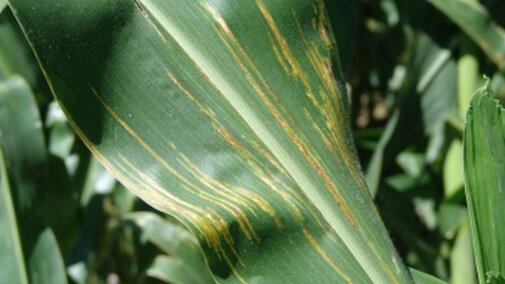Bacterial Leaf Streak (Figure 1) of corn (Zea mays) was first reported in Nebraska in 2016, also the first time the disease had been reported in the United States. Since then, it has been confirmed in eight more states: Colorado, Illinois, Iowa, Kansas, Minnesota, Oklahoma, South Dakota, and Texas.
In Nebraska preliminary results from a bacterial leaf streak survey (funded by the Nebraska Corn Board) in 2016 confirmed the disease on samples from 56 Nebraska counties (Figure 2). The 2017 survey is focusing on identifying the disease in areas of the state where it wasn’t previously confirmed to raise more awareness about this disease.
The causal agent of BLS is Xanthomonas vasicola pv. vasculorum. This pathogen has also been reported on corn in South Africa. The bacterium causes gumming disease of sugarcane (Saccharum spp.) worldwide. Grain sorghum and related species (Sorghum spp.) have been reported as susceptible hosts, but this has only been observed in greenhouse studies. The disease has not been confirmed in Nebraska sorghum fields at this time, although a closely related pathogen causes bacterial leaf streak with similar symptoms. Susceptible types of corn include field corn, seed corn, popcorn, and sweet corn.
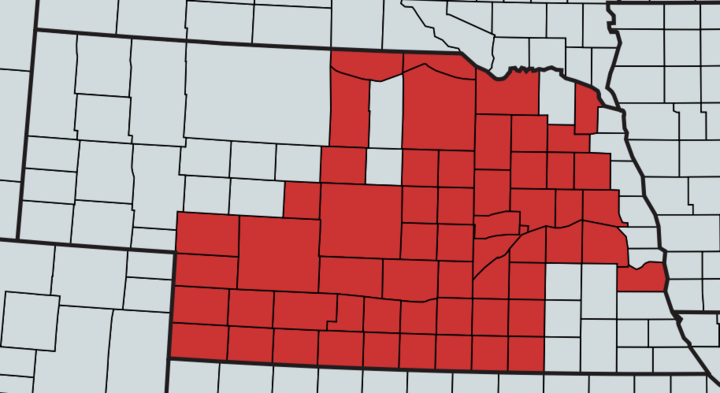
Figure 2. Confirmed distribution of bacterial leaf streak in Nebraska 2016-2017.
Symptoms and Signs
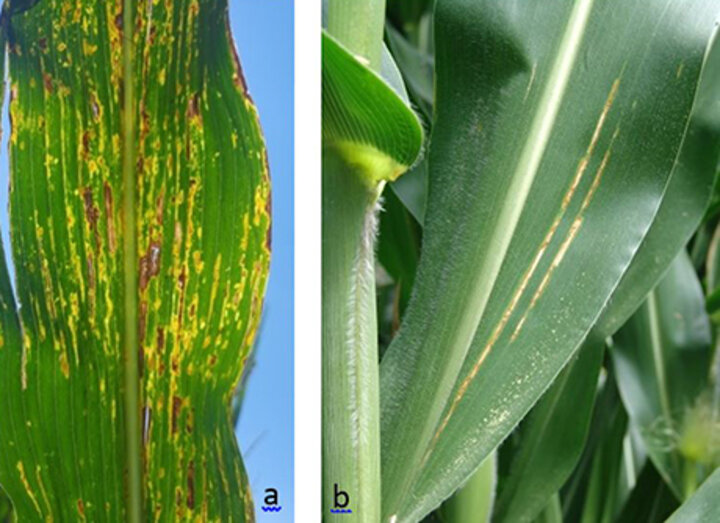
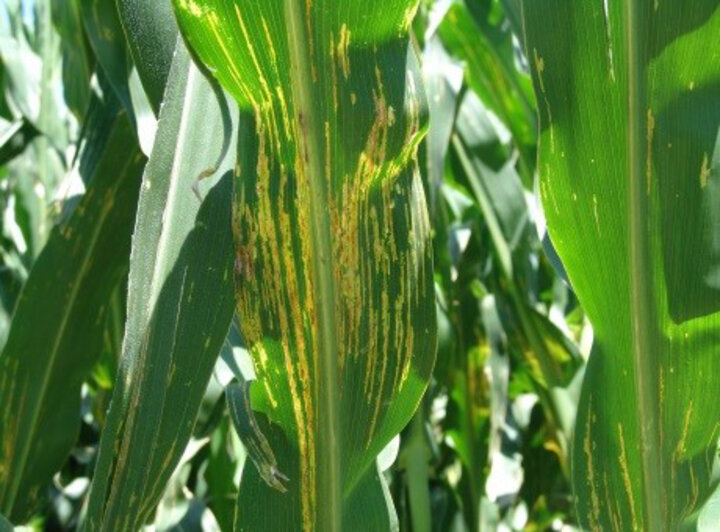
Symptoms of bacterial leaf streak include interveinal leaf streaks that are brown, tan, or yellow and can be short or very long (Figures 3a and 3b). Lesions are also strikingly yellow when backlit against the sun (Figure 4). Bacterial leaf streak margins are often wavy, jagged, and have a yellowish hue. Infection can occur at several corn developmental stages. Lesions have been confirmed in the field as early as the V4 growth stage, but in the greenhouse, plants can develop symptoms immediately upon seedling emergence.
Symptoms most often develop initially on the lower leaves. In some instances, lesions can develop in the mid- to upper- canopy without signs of infection in the lower canopy following storms or heavy rains. In this case, lesions often develop in concentrated spots around the midrib. Lesion appearance and symptoms may differ among hybrids and corn varieties, which can make initial diagnosis difficult. Upon further inspection in a lab, microscopic observation of bacterial streaming can rule out other fungal diseases. To date, symptoms have only been reported on plant leaves. There has been no evidence of systemic infection, wilt, or premature plant death caused by this disease.
Bacterial leaf streak can be very difficult to differentiate from other corn diseases, especially without a hand lens or microscope. Initial symptoms can easily be confused with some other diseases of corn, especially gray leaf spot, caused by the fungus Cercospora zeae-maydis (Figure 5). Gray leaf spot lesions tend to have smooth, linear margins (Figure 6a) in contrast to the often jagged, wavy margins of bacterial leaf streak lesions (Figure 6b). Proper identification is important, as bacterial leaf streak is a bacterial disease not effectively controlled by the fungicides used to manage gray leaf spot.
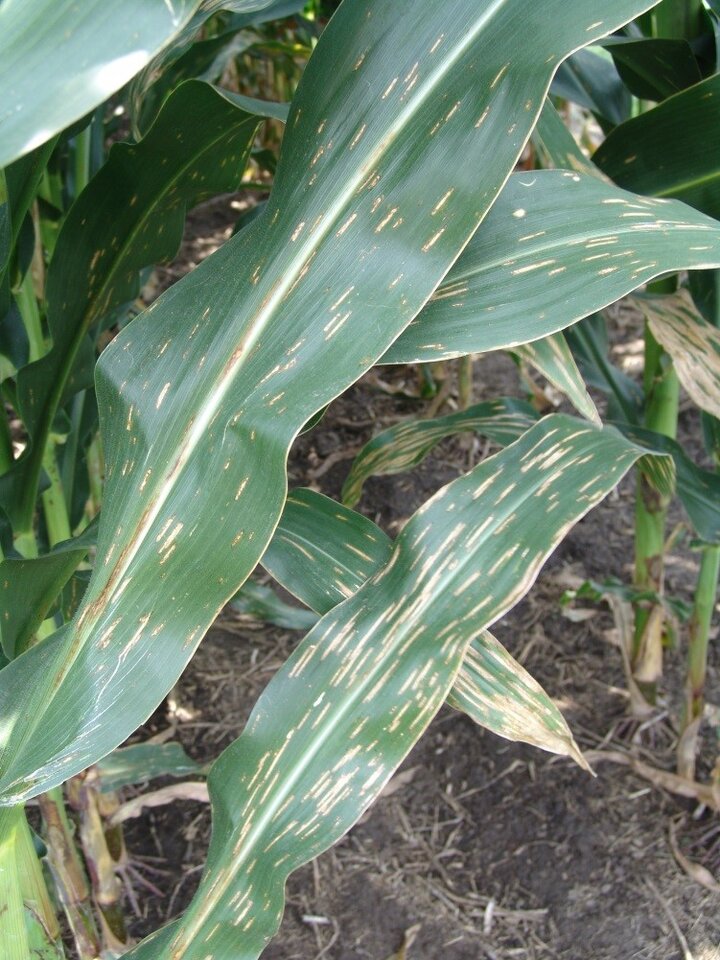
The yield loss potential caused by bacterial leaf streak is unclear because estimates are not yet available from ongoing research. However, disease severity—the magnitude of disease covering leaf area—will determine its impact on yield, particularly on grain fill. Yield loss is expected to vary widely among different fields and hybrids, ranging from little disease severity and negligible impact on yield to those that are severely affected with as much as 50% or more leaf area covered (Figure 7).
Disease Cycle
Three things are necessary for disease development:
- a virulent pathogen,
- a susceptible host, and
- favorable weather conditions.
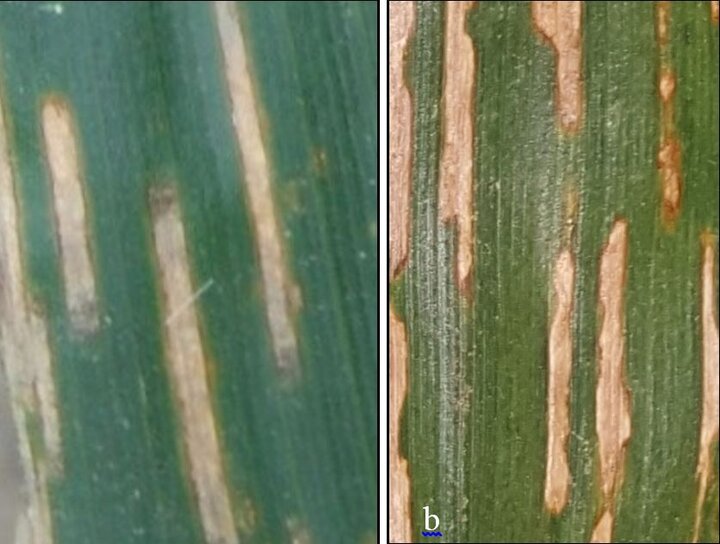
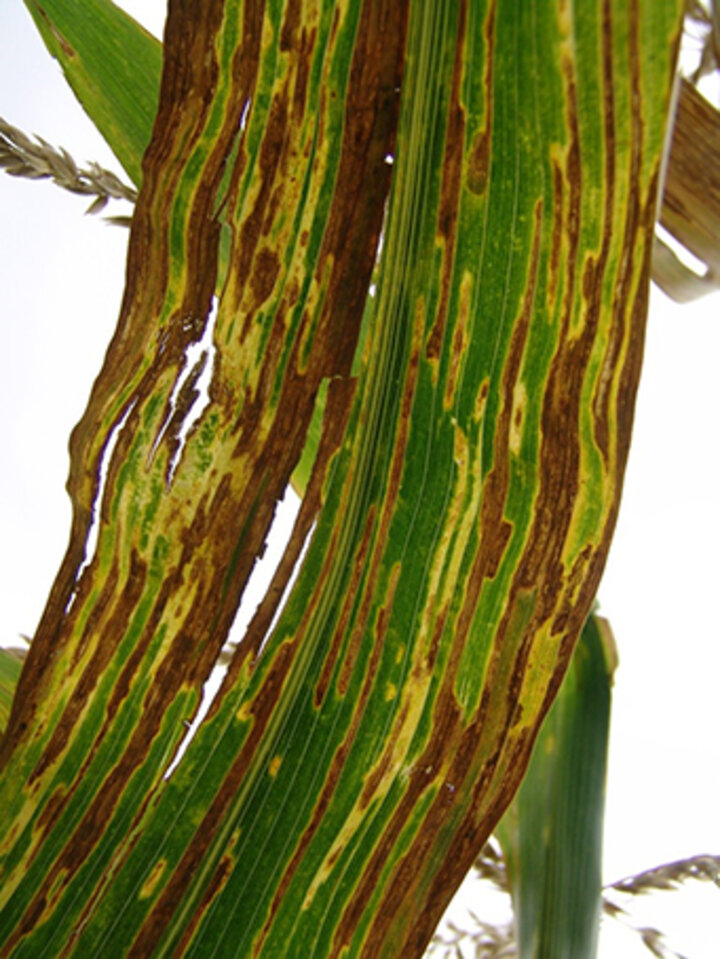
This bacterium likely overwinters in infected crop residue, acting as a source of inoculum for next year’s growing season and disease outbreak. Infection can develop in the same fields over several years if inoculum is available and susceptible hybrids are grown. The bacterium can likely infect plants via natural openings, such as stomata and sometimes wounds. Favorable environmental conditions for disease development include high relative humidity, leaf wetness, continuous corn, and minimum tillage. Heavy rainfall and overhead irrigation also may favor bacterial infection. Infected plant residue can likely spread between fields with baling operations, tillage equipment, combines, wind dispersal, or stalk feeding.
Preliminary results from experiments indicate seed transmission of the bacteria to be at very low or undetectable levels (Arias et al. 2017). It is unclear if this will be an important mode of pathogen movement. There are no known adverse impacts on livestock or human health from this pathogen.
Management
Crop rotation with non-host crops, such as soybean or wheat, and away from a continuous corn system are expected to help manage this and similar diseases caused by pathogens in the residue. However, while crop rotation can help, it is also essential to manage volunteer corn during the rotation as it can harbor the bacteria from year to year. Results from greenhouse experiments have shown that several plant species commonly found in or near corn fields can also become infected by the bacteria (Table 1). This includes several species of weeds, native grasses, and crops that may be planted as cover crops or in a rotation with corn. Experiments are being conducted in the field on these species to determine if, in a natural environment, the weeds will develop bacterial leaf streak and further contribute to disease outbreaks.
Weed management may play a role in disease mitigation, as it prevents host weeds from harboring the bacteria when corn is not grown in the field. Infected pasture grasses can become a source of pathogen spread if they are baled for livestock feed and moved to other areas. If a susceptible crop is planted in or near a field with a history of bacterial leaf streak, the plants should be monitored for symptoms of bacterial leaf streak. Although these plants showed bacterial leaf streak symptoms in greenhouse testing, other factors in the field influence disease development, and infection may not occur in a field setting.
| Diseased | No Disease | No Disease | No Disease |
|---|---|---|---|
| Oat ‘Jerry’ | Annual Ryegrass | Foxtail Millet | Sand Dropseed |
| Green Foxtail | Barley | Giant Foxtail | Sideoats Grama |
| Bristly Foxtail | Barnyardgrass | Kentucky Bluegrass | Smooth Brome |
| Yellow Nutsedge | Bermudagrass | Large Crabgrass | Switchgrass |
| Indiangrass | Cereal Rye | Meadow Brome | Tall Fescue |
| Orchardgrass | Creeping Bentgrass | Prairie Sandreed | Triticale |
| Big Bluestem | Creeping Foxtail | Pubescent Wheatgrass | Wheat |
| Little Bluestem | Downy Brome | Sandbur | Yellow Foxtail |
| Timothy | Fall Panicum |
Tillage may be an effective management strategy if it is already used in the cropping system although it may not be desirable or practical in some farming systems, such as for no-till farmers. Bacterial leaf streak has been observed in hybrids across most seed companies, but some vary in disease severity. Currently, no hybrids are immune to bacterial leaf streak. Proper identification of this disease is crucial as it can easily be confused with fungal diseases, like gray leaf spot. Bacterial leaf streak cannot be managed with a fungicide application as it is a bacterial disease. Research on disease management with bactericides is underway, but repeated applications may be required to be effective. Repeated applications of bactericides may not be economical on field corn compared to higher value crops like popcorn or sweet corn.
Sanitation can help slow pathogen spread from field to field. Removing infested crop debris from equipment is a good strategy to prevent pathogen spread. Harvesting severely infected fields last also may help prevent or slow pathogen spread, although wind can still move infected residue.
Acknowledgements
We gratefully acknowledge support from the Nebraska Corn Board, USDA-APHIS Farm Bill, and Monsanto Corporation for supporting these projects. The authors acknowledge technical assistance and other contributions from Brad Tharnish and Dr. Jim Harbour.
Resources
For more information see:
- Bacterial Leaf Streak in the Corn Disease Management section of CropWatch https://cropwatch.unl.edu/bacterial-leaf-streak
- Bacterial Leaf Streak (CPN-2008-W) from the Crop Protection Network at http://cropprotectionnetwork.org/corn/cpn-2008-bacterial-leaf-streak/
References
Arias, S., Block, C., Mayfield, D., Jackson-Ziems, T., Broders, K., Munkvold, G. 2017. Occurrence of Xanthomonas vasicola pv. vasculorum on maize seeds in the United States. Phytopathology. (Submitted meeting abstract APS August 2017).
Hartman, T., Harbour, J., Tharnish, B., Van Meter, J., Jackson-Ziems, T.A. 2017. Epidemiology and distribution of bacterial leaf streak of corn caused by Xanthomonas vasicola. Phytopathology. (Submitted meeting abstract APS August 2017).
Hartman, T., Tharnish, B., Harbour, J., Jackson-Ziems, T. A. 2017. Alternative hosts of Xanthomonas vasicola causing bacterial leaf streak of corn. Phytopathology. (Submitted meeting abstract NCAPS June 2017).
Hartman, T., Tharnish, B., Harbour, J., Van Meter, J., Eskridge, K., Jackson-Ziems, T. A. 2017. Distribution of bacterial leaf streak of corn caused by Xanthomonas vasicola in Nebraska. Phytopathology. (Submitted meeting abstract NCAPS June 2017).
Korus, K., Lang, J. M., Adesemoye, A. O., Block, C. C., Pal, N., Leach, J. E., Jackson-Ziems, T. A. 2017. First report of Xanthomonas vasicola causing bacterial leaf streak on corn in the United States. Plant Disease 101:1030 http://dx.doi.org/10.1094/PDIS-10-16-1426-PDN
Lang, J.M., DuCharme, E., Ibarra Caballero, J., Luna, E., Hartman, T., Ortiz-Castro, M., Korus, K., Rascoe, J., Jackson-Ziems, T.A., Broders, K., and Leach, J.E. 2017. Detection and characterization of Xanthomonas vasicola pv. vasculorum nov. causing bacterial leaf streak of corn in the United States. Phytopathology (Accepted June 29, 2017).
Lang, J.M., DuCharme, E., Ibarra, J., Luna, E., Korus, K., Hartman, T., Ortiz-Castro, M., Rascoe, J., Jackson-Ziems, T. A., Broders, K., and Leach, J.E. 2017. Detection and characterization of Xanthomonas vasicola pv. vasculorum pv. nov. causing maize bacterial leaf streak in the United States. Phytopathology. (Submitted meeting abstract APS August 2017).
Tharnish, B., Hartman, T., Harbour, J., Jackson-Ziems, T. A. 2017. Effects of high relative humidity on severity of bacterial leaf streak of corn caused by Xanthomonas vasicola in the greenhouse. Phytopathology. (Submitted meeting abstract NCAPS June 2017).
